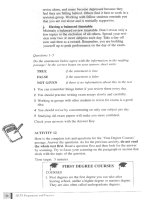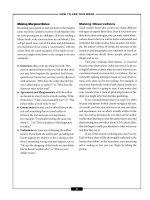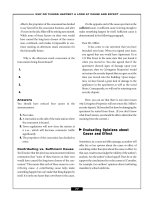Reading comprehension success part 4 doc
Bạn đang xem bản rút gọn của tài liệu. Xem và tải ngay bản đầy đủ của tài liệu tại đây (106.26 KB, 10 trang )
17
Building a
Strong
Foundation
Y
ou may not have thought of it this way before, but critical readers are a lot like
crime scene investigators. In their search for the truth, they do not let opin-
ions sway them; they want to know what actually happened. They collect tan-
gible evidence and facts and use this information to draw an informed conclusion.
Separating fact from opinion is essential during a crime scene investigation. It is also a cru-
cial skill for effective reading.
When you read, look for clues to understand the author’s meaning. What is this pas-
sage about? What is this writer saying? What is his or her message? At times, it may seem
like authors are trying to hide their meaning from you. But no matter how complex a piece
of writing may be, the author always leaves plenty of clues for the careful reader to find. It
is your job to find those clues. Be a good detective when you read. Open your eyes and ask
the right questions. In other words, read carefully and actively.
The five lessons that follow cover the basics of reading comprehension. By the end
of this section, you should be able to:
■
Find the basic facts in a passage
■
Determine the main idea of a passage
■
Determine the meaning of unfamiliar words from context
■
Distinguish between fact and opinionI
magine, for a moment, that you are a detective. You have just been called to the scene of a crime; a house
has been robbed. What’s the first thing you should do when you arrive?
a. See what’s on the TV.
b. Check what’s in the fridge.
c. Get the basic facts of the case.
The answer, of course, is c, get the basic facts of the case: the who, what, when, where, how, and why. What
happened? To whom? When? Where? How did it happen? And why?
As a reader faced with a text, you go through a similar process. The first thing you should do is establish the
facts. What does this piece of writing tell you? What happens? To whom? When, where, how, and why? If you can
answer these basic questions, you’re on your way to really comprehending what you read. (You’ll work on
answering the more difficult question—“Why did it happen?”—in Lesson 2.)
LESSON
Getting the
Essential
Information
LESSON SUMMARY
The first step in increasing your reading comprehension is to learn how
to get the basic information. Like a good detective, start with the basic
facts. To get the facts, be an active reader and look for clues as you
read.
1
19
What Are the Facts?
Let’s start with a definition. A fact is:
■
Something that we know for certain to have
happened
■
Something that we know for certain to be true
■
Something that we know for certain to exist
Much of what you read, especially today in this
“Information Age,” is designed to provide you with
facts. You may read, for example, about a new office
procedure that you must follow; about how the new
computer system works; about what happened at the
staff meeting. If you’re taking a standardized test, you’ll
probably have to answer reading comprehension ques-
tions that ask about the facts in a reading passage.
These facts are not always easy to determine, especially
if the writing is dense or complicated. To make it sim-
pler, ask yourself these questions as you read: What
facts am I expected to know? What am I to learn or be
aware of? What happened? What is true? What exists?
Practice Passage 1
Jump right into the task of finding facts. The following
brief passage is similar to something you might see in
a newspaper. Read the passage carefully, and then
answer the questions that follow. Remember, careful
reading is active reading (see the Introduction), so
mark up the text as you go. Underline key words and
ideas; circle and define any unfamiliar words or phrases;
and record your reactions and questions in the margins.
– GETTING THE ESSENTIAL INFORMATION–
20
On Friday, October 21, at approximately 8:30 a.m., Judith Reynolds, owner of
The Cupcake Factory, arrived at her establishment to find that it had been
robbed and vandalized overnight. The front window of the shop at 128 Broad
Street was broken, and chairs and tables were overturned throughout the café
area. Additionally, the cash register had been pried open and emptied of money.
The thieves attempted to open the safe as well, but were unsuccessful. Ms.
Reynolds used her cell phone to report the crime to the police. She also phoned
the proprietor of Primo Pizza, located at 130 Broad Street, as she noticed that the
door of that restaurant showed signs of forced entry. The police department is
asking anyone with information to call 555-2323.
1. What happened to The Cupcake Factory?
2. When was the crime discovered?
3. Where did it happen?
4. What was stolen?
5. Who called the police?
6. What other businesses were affected?
Remember, good reading is active reading. Did you mark up the passage? If so, it may have looked something
like this:
– GETTING THE ESSENTIAL INFORMATION–
21
On Friday, October 21, at approximately 8:30 a.m.,Judith Reynolds, owner of
The C
upcake Factor
y, arrived at her establishment to find that it had been
r
o
bbed and vandalized overnight. The front window of the shop at 128 B
roa
d
Str
eet was broken, and c
hairs and tables were o
ver
turned throughout the café
area
. Additionally, the cash r
egister had be
en pr
ied open and emptie
d of money
.
T
he thie
ves attempted to o
pen the safe as well, b
ut we
re unsuccessful. Ms.
Reynolds used her cell phone to report the crime to the police. She also phoned
the p
roprietor o
f Primo Pizza, located at 130 B
roa
d Street, as she noticed that the
door of that restaurant showed signs of forced entry. The police department is
asking anyone with information to call 555-2323.
You’ll notice that the answers to the questions
have all been underlined, because these are the key
words and ideas in this passage. But here are the
answers in a more conventional form.
1. What happened to The Cupcake Factory? It was
robbed and vandalized.
2. When was the crime discovered? At 8:30
A.M
.on
Friday, October 21.
3. Where did it happen? 128 Broad Street.
4. What was stolen? Money from the cash register.
5. Who called the police? Judith Reynolds, owner of
The Cupcake Factory.
6. What other businesses were affected? Possibly
Primo Pizza.
Notice that these questions went beyond the basic
who, what, when, and where to include some of the
details, like why the proprietor of the restaurant next
door was called. This is because details in reading com-
prehension, as well as in detective work, can be very
important clues that may help answer the remaining
questions: Who did it, how, and why?
when who
another
business
was affected
what happened—
robbery and
vandalization
unclear if anything was
taken from Primo Pizza
from this report
what a
mess!
money was
stolen
interesting
detail
where
Practice Passage 2
This passage includes instructions for renewing a driver’s license. Read it carefully and answer the questions
that follow.
– GETTING THE ESSENTIAL INFORMATION–
22
Instructions for License Renewal
A driver’s license must be renewed every four years. A renewal application is sent
approximately five to seven weeks before the expiration date listed on the license.
Individuals who fail to renew within three years of the license expiration date are
not eligible for a renewal and must repeat the initial licensing process. To renew
a license, you must visit a Motor Vehicles Agency. You must present a completed
renewal application; your current driver’s license; acceptable proof of age, iden-
tification, and address; and proof of social security in the form of a social secu-
rity card, a state or federal income tax return, a current pay stub, or a W-2 form.
You must also pay the required fee. If all the documents and payment are in order,
your photo will be taken and a new license will be issued.
7. What documents does one need to renew a
driver’s license?
8. What documents represent proof of social
security?
9. How often must one renew a driver’s license?
10. How does one obtain the renewal form?
11. True or False: You can renew your driver’s license
by mail.
Before you look at the answers, look at the next
page to see how you might have marked up the passage
to highlight the important information.
Instructions for License Renewal
A dr
iver’s license must be renewed every four years.A renewal application is sent
approximately five to seven weeks before the expiration date listed on the license.
Individuals who fail to renew within three years of the license expiration date are
not eligible for a renewal and must repeat the initial licensing process. To renew
a license, you must visit a M
otor Vehicles A
gency. You must present a completed
renewal application; your current driver’s license; acceptable proof of age, iden-
tification, and address; and proof of social security in the form of a social secu-
rity card, a state or federal income tax return, a current pay stub, or a W-2 form.
Y
ou must also pa
y the require
d fee. If all the documents and payment are in order,
your photo will be taken and a new license will be issued.
– GETTING THE ESSENTIAL INFORMATION–
23
documents
needed
for renewal
application will
be mailed
bring checkbook!
must go in
person. find
out nearest
location
how often I need to renew
With a marked-up text like this, it’s very easy to
find the answers.
7. What documents does one need to renew a
driver’s license?
Completed renewal application
Current driver’s license
Acceptable proof of age, identification,
and address
Proof of social security
Money to pay required fee
8. What documents represent proof of social
security?
Social security card
State or federal income tax return
Current pay stub
W-2 form
9. How often must one renew a driver’s license?
Every four years.
10. How does one obtain the renewal form? It is sent
five to seven weeks before current license expires.
11. True or False: You can renew your driver’s license
by mail. False: You can only renew by visiting a
Motor Vehicles Agency.
Practice Passage 3
Now look at one more short passage. Again, read carefully and answer the questions that follow.
– GETTING THE ESSENTIAL INFORMATION–
24
Today’s postal service is more efficient and reliable than ever before. Mail that
used to take months to move by horse and foot now moves around the country
in days or hours by truck, train, and plane. First-class mail usually moves from
New York City to Los Angeles in three days or less. If your letter or package is
urgent, the U.S. Postal Service offers Priority Mail and Express Mail services.
Priority Mail is guaranteed to go anywhere in the United States in two days or
less. Express Mail will get your package there overnight.
12. Who or what is this passage about?
13. How was mail transported in the past?
14. How is mail transported now?
15. How long does first-class mail take?
16. How long does Priority Mail take?
17. How long does Express Mail take?
Once again, here’s how you might have marked
up this passage:
Today’s postal service is more efficient and reliable than ever before. Mail that
used to take months to move by ho
rse and foot now moves around the country
in days or hours by truck, train, and plane. First-class mail usually moves from
New York City to Los Angeles in three days or less. If your letter or package is
urgent, the U.S. Postal Service offers Priority Mail and Express Mail services.
Priority Mail is guaranteed to go anywhere in the United States in two days or
less. Express Mail will get your package there overnight.
You can see how marking up a text helps make it
easier to understand the information a passage conveys.
12. Who or what is this passage about? The U.S.
Postal Service.
13. How was mail transported in the past? By horse
and foot.
14. How is mail transported now? By truck, train,
and plane.
15. How long does first-class mail take? Three days
or less.
16. How long does Priority Mail take? Two days or
less.
17. How long does Express Mail take? Overnight.
What a
long time!
3 services listed–
First class–3 days
Priority–2 days
Express–Overnight
Fastest
then
Are there
other
services?
now
Summary
Active reading is the first essential step to comprehen-
sion. Why? Because active reading forces you to really
see what you’re reading, to look closely at what’s there.
Like a detective who arrives at the scene of a crime, if
you look carefully and ask the right questions (who,
what, when, where, how, and why), you’re on your way
to really comprehending what you read.
– GETTING THE ESSENTIAL INFORMATION–
25
Here are some suggestions for practicing the skills covered in this chapter throughout the day and even
the rest of the week. Try them!
■
Mark up everything you read throughout the day—the newspaper, a memo, a letter from a friend. Under-
line the key terms and ideas; circle and look up any unfamiliar words; write your reactions and ques-
tions in the margins. If possible, share these reactions with the writer and see if you can get answers
to your questions.
■
Develop a “detective’s eye.” Begin to notice things around you. Look at the details on people’s faces;
notice the architectural details of the buildings you enter. The more observant you are in daily life, the
more enriched your life will be and the easier it will be to comprehend everything you read.
Skill Building until Next Time









